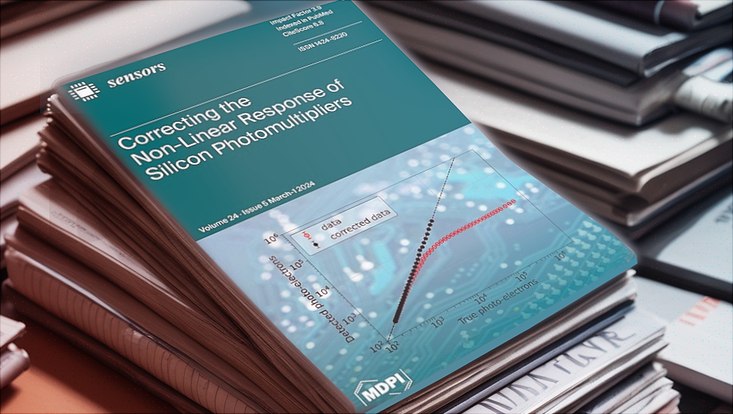Correcting the non-Linear Response of Silicon Photomultipliers
26 June 2024

Photo: Sensors
Silicon PhotoMultipliers (SiPMs) are efficient light detectors which can sense single photons and are used in high-energy physics, medical imaging and astronomy. Researchers from the Quantum Universe cluster of excellence have recently devised a method to correct the non-linear response of SiPMs using only SiPM measurements, independent of knowledge about the light source or its linearity. This method extends the usable linear dynamic range of SiPMs by over ten-fold and the publication has been featured on the cover of the journal Sensors.
Silicon PhotoMultipliers (SiPMs) are pixelated photo-detectors operating in Geiger mode which can detect and count single photons with good time resolution. They are commonly used in applications requiring high spatial resolution like high-energy physics and medical imaging, as well as for their high photo-detection efficiency in astrophysics, space detectors, and LIDAR (light detection and ranging) systems. SiPMs have a non-linear detection range from one to several thousand photons.
The researchers have devised a method to correct the non-linear response of SiPMs using only SiPM measurements, independent of light source knowledge or its linearity. The method involves uniformly illuminating the SiPM surface with two superimposed tunable light sources, LED and laser, of varying amplitude and arrival time. This eliminates the challenging requirement to provide a single reference linear light source. With two sources, shifted in time, the calibration can correct the SiPM detector response to linearity within 5%.
Through this technique, the SiPMs' non-linear response has been effectively corrected and the linear dynamic range of the detector has been expanded by over ten-fold. In the future, this method can be calibrated using a test stand in conditions akin to the final experiments where it will be applied.
